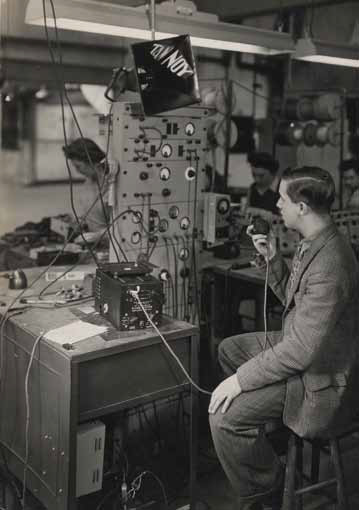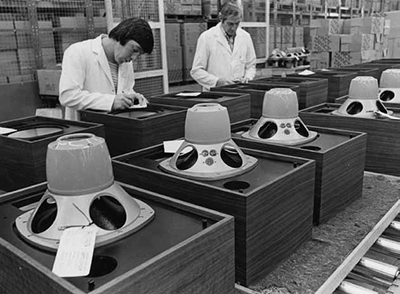The foundational elements that will drive Tannoy’s future
Tannoy’s Coatbridge, Scotland factory came online in 1976 and is at present under refurbishment to complete ISO:9001 certification and expand visitor and training facilities. The saying goes that you don’t need to reinvent the wheel, but what if you do and then apply that new technology across a broad range of products, justifying the reinvention? Rather than inventing for the sake of invention, the objective would be to carve out a new foundation for growth, each rare and thorough reinvention providing another pillar for a much larger enterprise.
Nearly a century ago, as radio broadcasting was taking shape, invention was abundant, but there was one particularly striking new wheel built by Guy R. Fountain. He saw how clunky and difficult-to-recharge lead-acid batteries were impeding the arrival of radios into consumers’ homes, and in 1926, he built a lighter battery from Tantalum and an alloy of lead. Together, these elements formed the manufacturer known as Tannoy, which from its first innovation has applied its technologies widely throughout consumer and professional sound production applications.
By the 1940s, Tannoy’s reach extended to nearly every aspect of the music industry, from live sound and recording to home playback. But that was just the first chapter of a company history rich in audio evolution. Ronnie H. Rackham, Tannoy’s chief engineer in that era, noted the destructive interference that occurred when two transducers were physically separated, even by mere inches. He sought to create a true point-source radiator, and opting to avoid the pitfalls of the horns and acoustical lenses applied in other coaxial driver designs of the era, Tannoy again went to the foundation and created a low-frequency drive cone that also behaved as a waveguide for the high-frequency compression driver nestled concentrically within it. Et voila, the legendary Tannoy Dual Concentric loudspeaker made its debut at the London Radio Show in 1947.

The legendary Tannoy Dual Concentric loudspeaker made its debut at the London Radio Show in 1947, and the technology is still a core component to the manufacturer’s product lines today. Today, Dual Concentric technology is applied up, down, and across Tannoy’s products for the installation, sound reinforcement, consumer, and recording verticals. The company’s steadfast roots show not just in its products, but also in the long-term dedication of the people that lead and drive its manufacturing and development efforts. “There’s a great loyalty at Tannoy, a very close-knit community,” observed Dr. Paul Mills, director of research and engineering, residential products, and himself clocking in at the 25-year mark with the manufacturer. “There’s also a very strong belief in Dual Concentric technology, we wouldn’t imagine wanting to work with anything else, really. “
As proof, on a recent calculation, it was discovered that Tannoy team members averaged 16.5 years with the company, with a great many of those carrying more than two decades of experience with them, and 10 that have been working in the Coatbridge, Scotland headquarters location since it opened in 1976. Some families have been with the Tannoy brand for two generations and counting.
The metrics aren’t the thing, though. “Whilst people come here of course to earn a living, it’s surprising how many people in the factory feel really connected with the brand,” noted Tannoy managing director Andrzej Sosna. This being the case, when Sosna took the helm at Tannoy in 2006, one of the first questions he heard was about the building lease that would expire eight years later. “That’s how far our employees are thinking ahead,” he said. “When I announced that we were staying and refurbishing the existing building, the atmosphere in the place changed almost overnight.”
This passion informs the precision with which Tannoy products are designed, built, finished, sold, and installed. Up and down the line at the company, there is consideration for how each step, each decision will affect the end result.
That philosophy already firmly in place, it probably seemed natural for Tannoy to dive into the ISO:9001 certification process in tandem with the refurbishment of its factory that began in the past 12 months. Beyond the cosmetic improvements that will open the front of the building up into a modern expanse of glass windows shedding new light onto customer reception, training, and full-scale listening facilities, the improvements are logistical as well.
Concurrent with the changes, there is much talk of bringing Tannoy into the 21st century with facilities updates and personnel hiring and apprenticeships, but this isn’t merely to keep pace. Tannoy left any vestiges of the recession behind years ago and sales have in fact ascended to levels today that exceed any in the company’s history, Sosna indicated.
With production levels at their peak and growing, “We cannot afford for operators to have any downtime,” observed Gabriel O’Donohue, Tannoy operations manager, a 27-year veteran of the company. Section by section, the factory floor and its various testing stations have been updated and streamlined so that even the number of unnecessary footsteps is reduced in the production of Tannoy’s high-end, residential and professional audio loudspeakers.
O’Donohue detailed how improvements made to the production process not only increase efficiency, but provide greater ease and comfort for those assembling product across the nine designated workstation areas. Data tracked and monitored on the factory floor and discussed at weekly production meetings already demonstrates booming productivity as a result of the changes.
The refurbishment of factory floor and offices is expected to be complete this summer, but design and manufacturing improvements are continuous within Tannoy, as overseen by design development manager Stuart Wilkinson. Another member of the Tannoy team who joined the company straight out of university, with his tenure so far clocking in at 23 years, Wilkinson ushers products through each phase of the design and manufacturing process with close attention to the aesthetic and mechanical details that put the finishing touch on the ideas and concepts generated by engineering and customer requests from the field. “We try to work fast and be flexible to satisfy our customers’ needs,” Wilkinson said, with an emphasis on guiding products from the conceptual phase through to completion “on time and on budget.”

Tannoy’s QFlex loudspeakers have gained much traction in reverberant spaces such as transportation hubs, like Glasgow Central Station.

By the 1940s, Tannoy’s reach extended to nearly every aspect of the audio industry. Production line metrics and the ongoing improvement efforts of Tannoy’s operations management team are an outward manifestation of a company ethos of innovation founded in practical application. Engineering and product development coalesces customer input from the field with technological innovation to build products that meet market demands and provide headroom for continued evolution. Products built today fit onto a Tannoy roadmap that takes into account not only Tannoy’s intentions, but also the larger goals of its parent company, TC Group. “We share a common and aligned strategy, but our own specific product roadmap,” explained Tannoy director of engineering Philippe Robineau. Posted on the wall of his office is a multi-colored and multi-tiered chart to this effect, and the number of objectives on it looks pretty impressive.
A Frenchman in a Scottish company, Robineau launched his career in audio with the birth of NEXO in 1979. He joined Tannoy in 1995, attracted by the opportunity to work across the various markets served by the company, including high-end audiophile, mid-range hi-fi, studio monitors, pro commercial product, PA , and more. His first stint with Tannoy lasted four years, but Robineau found himself returning to the “family” in 2008, unable to resist the next technological challenge that came with the development of the beam steering technology that would result in the QFlex product line. The success of this consultant-favorite has placed QFlex firmly in large-scale major transportation hubs, continuing the tradition of a “Tannoy” being the noun interchangeable with public address.
A key mastermind behind one of the most significant product milestones since Dual Concentric, Robineau and the Tannoy engineering team are thinking in systems these days. “The market is coalescing,” Sosna observed. “People are looking for more and more combined systems.”
The most recent example of this approach is in the logical connection between Tannoy’s core market commercial install speakers and Lab.gruppen’s new LUCIA amplifier series. Lab.gruppen brings its own proven performance audio credentials and kudos to the Tannoy mix, explained VP of marketing Mark Flanagan. “New Lab.gruppen products like LUCIA and E Series provide more aligned and symbiotic connections with Tannoy, allowing us to deliver better solutions for our customers and ultimately better outcomes for the end-users.” While not built for exclusive use with Tannoy products (Lab.gruppen’s success seems to know no bounds), these amps were “developed to take advantage of Tannoy’s best qualities,” Flanagan noted. “It’s the best vocal and music reproduction brought by Tannoy, merged with best of breed, ultra-reliable Swedish amps.”
Support for these collaborative principles goes right down the line, with the T.C. Group’s Application Engineering and Training (AET), founded by Tannoy’s Graham Hendry. Based in Austin, TX, but providing global reach, AET has achieved success across its application support, education, and training efforts. Hendry and fellow AET founded Joshua Evans come from an engineering background (with Tannoy stalwart Hendry starting his company tenure as Dr. Mills’ lab technician and creating another technology milestone with his launch of the VQ series nine years ago), “and we’ve both been customers,” Hendry pointed out. “You can’t really know what the customer wants unless you’ve been one yourself,” he quipped, adding that internal design support such as that provided by AET offers the benefit of “we know our product better than anyone, so we’ll help the customer choose the right option.”
The AET group is just the latest chapter in Tannoy’s North American reach, with the manufacturer’s Kitchener, Ontario, Canada office firmly establishing Dual Concentric in the U.S. market in the 1990s, with the help of the CMS Series of ceiling speakers. CEO of TC Group Americas Marc Bertrand tapped ample market demand for high-fidelity audio from the much-maligned ceiling category and brought the Tannoy reputation to eager ears, establishing the brand on firm footing across the pond.
Visiting the source of this reputation, Tannoy’s Scottish headquarters, one gets the impression that the legacy behind the brand is what will carry it into the future. Beyond a mere continuation of what already exists, it is impetus for continued refinement. “This brand, I’m a steward,” Sosna said. “It’s a solid brand with a fantastic heritage. We’re building on it.”
